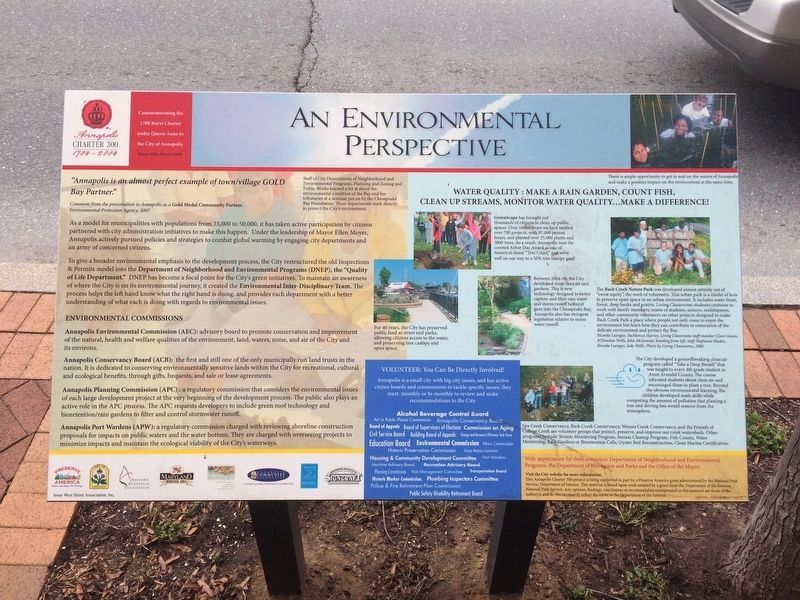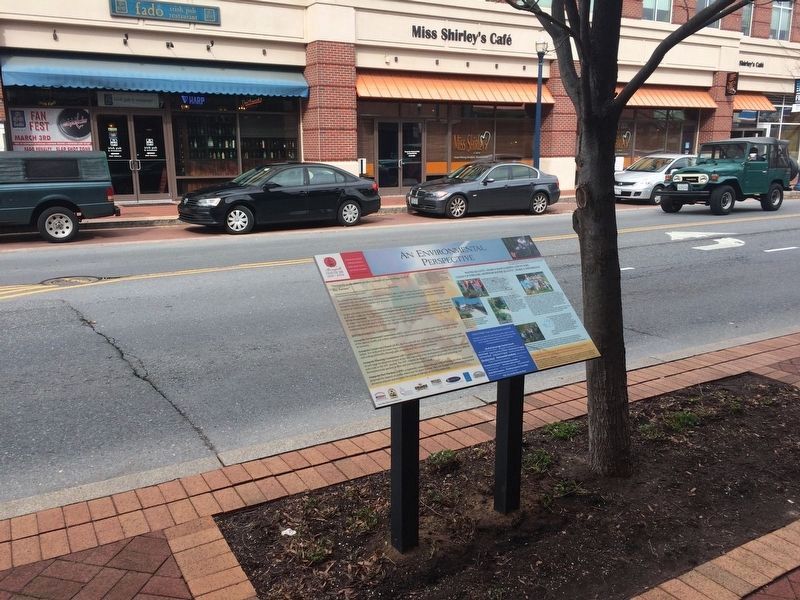Annapolis in Anne Arundel County, Maryland — The American Northeast (Mid-Atlantic)
An Environmental Perspective
Annapolis Charter 300 1708-2008
— Commemorating the 1708 Royal Charter under Queen Anne to the City of Annapolis —
Comment from the presentation to Annapolis as a Gold Medal Community Partner.
Environmental Protection Agency, 2007
As a model for municipalities with populations from 35,000 to 50,000, it has taken active participation by citizens partnered with city administration initiatives to make this happen. Under the leadership of Mayor Ellen Moyer, Annapolis actively pursued policies and strategies to combat global warming by engaging city departments and an army of concerned citizens.
To give broader environmental emphasis to the development process, the City restructured the old Inspections & Permits model into the Department of Neighborhood and Environmental Programs (DNEP), the "Quality of Life Department." DNEP has become a focal point for the City's green initiatives. To maintain an awareness of where the City is on its environmental journey, it created the Environmental Inter-Disciplinary Team. The process helps the left hand know what the right hand is doing, and provides each department with a better understanding of what each is doing with regards to environment issues.
Environmental Commissions
Annapolis Environmental Commission (AEC): advisory board to promote conservation and improvement of the natural, health and welfare qualities of the environment, land, waters, noise, and air of the City and its environs.
Annapolis Conservancy Board (ACB): the first and still one of the only municipally run land trusts in the nation. It is dedicated to conserving environmentally sensitive lands within the City for recreational, cultural and ecological benefits, through gifts, bequests, and sale or lease agreements.
Annapolis Planning Commission (APC): a regulatory commission that considers the environmental issues of each larger development project at the very beginning of the development process. The public also pays an active role in the APC process. The APC requests developers to include green roof technology and bioretention/rain gardens to filter and control stormwater runoff.
Annapolis Port Wardens (APW): a regulatory commission charged with reviewing shoreline construction proposals for impact on public waters and the water bottom. They are charged with overseeing projects to minimize impacts and maintain ecological viability of the City's waterways.
For 40 years, the City has preserved public land as street end parks, allowing citizens access to the water, and preserving tree canopy and open space.
Between 2004-08, the City developed more than 60 rain gardens. This is new technology designed to better capture and filter rain water and storm runoff before it goes into the Chesapeake Bay. Annapolis also has a stringent legislation relative to storm water runoff.
The Back Creek Nature Park was developed almost entirely out of "sweat equity", the work of volunteers. This urban parks is a model of how to preserve open space in an urban environment. It includes water front, forest, deep banks and prairie. Living Classrooms students continue to work with family members, teams of students, seniors midshipmen, and other community volunteers on other projects designed to make Back Creek Park a place where people not only come to enjoy the environment but learn how they can contribute to restoration of the delicate environment and protect the Bay.
Ricardo Luengas, NaMarcco Harvey, Living Classrooms staff member Clare Giesen, B'Donshee Wells, John McGowan; kneeling from left: staff-Stephanie Blades, Brenda Luengas, Jade Wells. Photo by Living Classrooms, 2006
The City developed a groundbreaking clean air program called "Take a Deep Breath" that was taught to every 4th grade student in Anne Arundel County. The course educated students about clean air and encouraged them to plant a tree. Beyond the obvious environmental learning, the children developed math skills while computing the amount of pollution that planting a tree and driving less would remove from the atmosphere.
Spa Creek Conservancy, Back Creek Conservancy, Weems Creek Conservancy, and the Friends of College Creek are volunteer groups that protect, preserve, an improve our creek watersheds. Other programs include: Stream Monitoring Program, Stream Cleanup Program Fish Counts, Water Monitoring, Rain Gardens or Bioretention Cells, Oyster Bed Reconstruction, Clean Marina Certification.
With appreciation for their assistance: Department of Neighborhood and Environmental Programs, the Department of Recreation and Parks and the Office of the Mayor.
Visit the City website for more information.
This Annapolis Charter 300 project is being supported in part by a Preserve America grant administered by the National Park Service, Department of Interior. This material is based upon work assisted by a grant from the Department of the Interior, National Park Service. Any opinion, findings, conclusions or recommendations expressed in this material are those of the author(s) and do not necessarily reflect the views of the Department of the Interior.
Erected by the City of Annapolis.
Topics. This historical marker is listed in these topic lists: Charity & Public Work • Environment • Waterways & Vessels. A significant historical year for this entry is 1978.
Location. 38° 58.59′ N, 76° 30.178′ W. Marker is in Annapolis, Maryland, in Anne Arundel County. Marker is on West Street (Maryland Route 450) east of Park Place, on the right when traveling west. Touch for map. Marker is at or near this postal address: 261 West Street, Annapolis MD 21401, United States of America. Touch for directions.
Other nearby markers. At least 8 other markers are within walking distance of this marker. The City Water System (here, next to this marker); Sharpening Our Governing Teeth: The 1708 Charter of Annapolis (about 400 feet away, measured in a direct line); Brown-Leanos Memorial Park (about 400 feet away); Annapolis During The Civil War (about 500 feet away); Light House Bistro (about 600 feet away); A National Cemetery System (about 700 feet away); Annapolis National Cemetery (about 700 feet away); Anne Catharine Green (about 800 feet away). Touch for a list and map of all markers in Annapolis.
Regarding An Environmental Perspective. While it primarily involves discussion about environmental efforts, it includes some of the history of these efforts in Annapolis.
Credits. This page was last revised on March 17, 2019. It was originally submitted on March 2, 2018, by Devry Becker Jones of Washington, District of Columbia. This page has been viewed 225 times since then and 16 times this year. Photos: 1, 2. submitted on March 2, 2018, by Devry Becker Jones of Washington, District of Columbia. • Bill Pfingsten was the editor who published this page.

